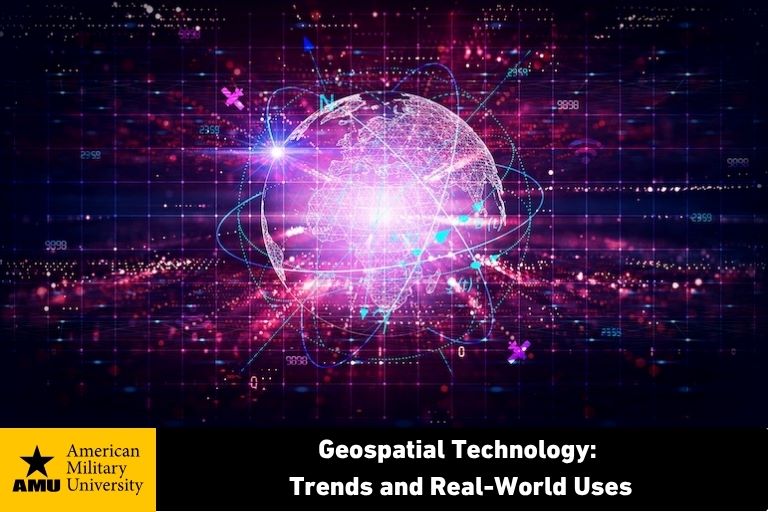By Leslie Doyle | 06/17/2025

At the height of the 1962 Cuban Missile Crisis, the Kennedy administration released aerial photos of Soviet missiles in Cuba taken from high-altitude airplanes. This use of geospatial intelligence served as crucial proof that the Soviet Union had placed ballistic missiles in Cuba, giving President Kennedy leverage during this precarious time.
In the past few decades, geospatial technology has undergone dramatic advancements, ranging from real-time global positioning systems (GPS) to drones.
What Is Geospatial Technology?
Geospatial technology involves the development of tools used to map, measure, and analyze geospatial data points tied to specific geographic locations. Mapping geospatial data points helps to reveal patterns and insights that might not be obvious in spreadsheets or text-based formats.
The analysis of geospatial data (also known as geographic mapping) provides scientists, policy makers, and others with invaluable insight into major challenges such as:
- Climate change tracking and mitigation
- Disease outbreaks
- Disaster response
- Humanitarian relief
- National security
- Infrastructure development and urban planning
- Agricultural monitoring
Types of Geospatial Software and Hardware Tools
Geospatial technology is made up of both software platforms and hardware tools that collect, display, and analyze spatial data. Understanding how these tools work together is key to applying geospatial insights across industries.
Geographic Information Systems
Internet mapping technologies like geographic information systems (GIS) bring together spatial and non-spatial data to help understand and reveal geographic patterns, relationships, and trends. By plotting information visually, GIS allows users to better understand data and make more informed, location-based decisions.
Usually, geographic information systems integrate location data and descriptive data. For example, during the COVID-19 pandemic, public health officials used GIS tools to map infection rates and allocate resources strategically.
Global Positioning Systems
A global positioning system (GPS) uses satellite feeds to provide real-time global navigation. Many of us leverage GPS technology daily when we use Google Maps® or the Bing Maps Platform® (formerly known as Microsoft Virtual Earth), a fitness tracker, or any ride-share app.
GPS works by collecting location data from satellites that orbit Earth and produce satellite imagery. These satellites transmit information about position and time to applications and electronic devices such as smartwatches and smartphones. Thanks to GPS, we receive alerts about traffic delays, track our hikes, and estimate arrival times with greater precision.
Light Detection and Ranging
Light detection and ranging (lidar) is a remote sensing method that uses laser pulses from aircraft to generate 3D maps of the Earth’s surface. Lidar can measure all kinds of environmental data such as air pollution and its sources, rising sea levels, and rates of deforestation.
Big Data in Geospatial Analysis
The immense volume of data collected from satellites, sensors, mobile devices, and other technological tools is unprecedented. The surge in geospatial “big data” requires specialized geospatial analytics tools and robust storage capabilities to manage and extract these data points in order to reach valuable insights.
Artificial intelligence (AI) and machine learning help automate data analysis, identify patterns, and build predictive models. Industries of all kinds employ these advanced geospatial analytics software tools to make more strategic, data-informed decisions.
Applying Geospatial Technology
Geospatial technology is used across a wide range of fields to support decision-making, improve public safety, and respond to emergencies. Geospatial tools can be applied in many real-world situations, such as:
- Law enforcement
- National security
- Public health
- Emergency response
- Urban planning
- Environmental monitoring
- Business
Law Enforcement
Law enforcement agencies use geospatial technology to gain a clear understanding of criminal activity and operational environments. For example, law enforcement agencies can use multiple data sets to support crime mapping and pattern analysis in their jurisdictions.
“The use of geospatial data and analysis supports their ability to gain knowledge of criminal operating patterns and behaviors while optimizing law enforcement’s ability to focus personnel and investigatory capabilities to enhance public safety,” says James Burch, Department Chair of Intelligence Studies at American Military University (AMU).
Additionally, law enforcement personnel and other emergency management agencies use geospatial technologies to support their response to natural and/or man-made disasters.
National Security
As a member of the U.S. Intelligence Community, the National Geospatial-Intelligence Agency (NGA) employs geospatial tools like unmanned aerial vehicles and other technologies to aid policymakers, military leaders, and intelligence professionals.
Advances in geospatial technologies continue to improve the accuracy and timeliness of threat intelligence in the military. “Much like law enforcement, the military uses geospatial technologies to categorize the operating environment and support a broad range of military activities,” says Dr. Burch.
The use of geospatial technologies helps military forces assess terrain, optimize logistics networks, and anticipate the placement of adversary assets or operations. The result is greater situational awareness and tactical readiness.
Public Health
A compelling and impactful use of geospatial data is for scientific understanding in public health. During rapidly shifting emergencies, such as disease outbreaks, officials rely on geospatial technology to assess where major outbreaks are occurring and respond accordingly.
Analyzing spatial data points, such as reported disease incidents, public health officials can more swiftly identify disease clusters and patterns of infection spread. These tools are also beneficial for tracking the effectiveness of intervention strategies in near real-time.
Emergency Response
GIS and remote sensing are powerful geospatial tools that support disaster management and emergency response. For first responders, these geospatial technologies can monitor points on a map and help predict events such as impending hurricanes.
When a disaster occurs, GIS and remote sensing technology enable government authorities, first responders, and others to understand conditions on the ground and coordinate their resource deployment to a precise location.
Since geospatial data is often available in real time, it allows for greater insight into rapidly changing situations. In one study, visualizing traffic accidents helped emergency teams respond 20% faster.
Urban Planning
Urban planners rely on geospatial technologies like internet mapping, satellite imagery, and spatial analysis to inform decisions about infrastructure, transportation, and sustainable growth.
Geospatial data, such as vector data, aids this type of planning. Unlike raster data, which displays information using pixels, vector data uses points and lines, which can be helpful for mapping sites such as roads and regional boundaries.
Using this data, city and town planners can create detailed maps, overlay zoning regulations, consider infrastructure needs, and gauge population growth needs.
Environmental Monitoring
Government agencies, conservation organizations, and researchers use geospatial technology and airborne cameras to forecast threats to the environment and combat climate change involving a specific location.
For example, raster data – organized in a grid format – captures geographic information like elevation, temperature, and vegetation density. Spatial analysis of this data can provide useful real-time information about different events. For instance, the precision available with geospatial technology aids in identifying and tracking the source of airborne pollutants.
GIS tools are essential for biodiversity conservation as well as fast-moving situations like forest fire suppression. In addition, remote sensing is used to monitor coastlines and ocean temperatures, track hurricanes and earthquakes, and understand impacts on wildlife.
Business
Businesses can apply geospatial technology in innovative and intriguing ways, ranging from meeting customer expectations to identifying ways to drive down costs. For example, geospatial analysis may be used for:
- Verifying on-time delivery of goods
- Identifying location-based consumer behaviors to personalize marketing
- Streamlining supply chain logistics
- Managing regulatory compliance
- Identifying regional skill clusters for workforce planning
The Legal Implications of Geospatial Technology Advances
“Technological advances – from smartphones and vehicles to RFID technologies – have implications for individual privacy,” says Dr. Burch. “While convenient, these advances can expose end users to being tracked and make them more vulnerable to exposure.”
The Future of Geospatial Technology
"Continued technological advances in remote sensing, geo-precision capabilities, miniaturization, and greater computer processing power supported by artificial intelligence are greatly advancing the accuracy, timeliness, and the potential of individuals to analyze large data sets in a visually enhanced depiction of the environment,” says Dr. Burch. “These technologies, when integrated in an aggregate fashion, allow users to quickly process and gain an in-depth understanding of the operational environment.”
Geospatial technologies continue to evolve as additional layers of geo-rectified data are developed to enhance visualization. As technological advances in remote sensing and geo-precision tools are integrated into vehicles, planes, and satellites and gain new or enhanced capabilities (such as miniaturized aerial vehicles and ground sensors), our ability to visually represent the environment will continue to improve. Coupled with increased computing power and AI, these developments promise more advanced, real-time analytics for both public- and private-sector use.
The Various Career Paths in the Geospatial Technology Field
In our increasingly data-driven society, there is a growing need for geospatial and GIS professionals. Common career paths in this field include:
- Cartographers – Design and create maps in collaboration with others
- Data scientists – Analyze spatial data to identify key patterns
- Geospatial engineers – Map geospatial data and perform predictive modeling
- Geospatial/GIS technicians – Use GIS and other digital software for data collection and analysis
- GIS analysts – Provide data analysis to analyze trends to support decision makers
- GIS developers – Create GIS programs
- Surveyors – Map various topographical features such as bodies of water to identify property boundaries
AMU’s Intelligence Studies Degrees
For adult learners who want to improve their knowledge of geospatial technology, geospatial intelligence, and related topics, AMU provides a choice of three degree programs:
- An online Bachelor of Arts in Intelligence Studies with a concentration in geospatial intelligence
- An online Master of Arts in Intelligence Studies
- An online Doctor of Strategic Intelligence (DSI)
Courses in these academic programs include intelligence collection, foreign intelligence organizations, applied geospatial intelligence, and international relations. Other courses involve intelligence analysis, ethical challenges in the Intelligence Community, nationalism and identity, and the psychology of actors in the global environment.
For more details, visit AMU’s intelligence degrees program page.
Google Maps is a registered trademark of Google, LLC.
Bing Maps Platform is a registered trademark of the Microsoft Corporation.
Leslie Doyle is an AMU staff writer, veteran writer, and editor with 15+ years of experience covering high-tech, biotech, and related business segments. Her previous clients include Cleveland Clinic, Massachusetts General Hospital, Blue Cross Blue Shield of Massachusetts, Adobe Systems, The MathWorks, Novell, Verizon Business, Sony Corporation, Tyco Fire & Security, and Avid Technology, as well as many startup companies. Her work has been covered in CIO Magazine, Forbes Magazine, Computer Technology Review, Bioinform, Scientific Computing and Instrumentation, and related publications. Leslie holds a bachelor’s degree in English from Framingham State College.

